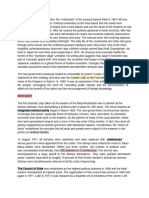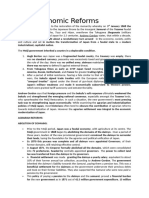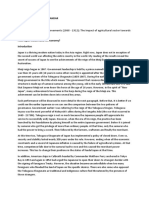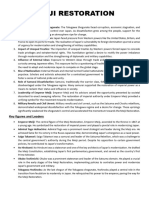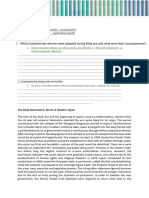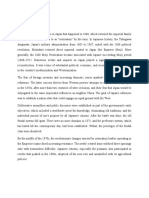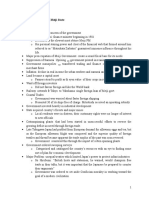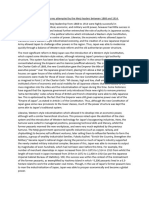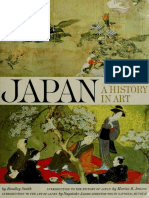Meiji Restoration
Meiji Restoration
Uploaded by
Kanika katariyaCopyright:
Available Formats
Meiji Restoration
Meiji Restoration
Uploaded by
Kanika katariyaOriginal Title
Copyright
Available Formats
Share this document
Did you find this document useful?
Is this content inappropriate?
Copyright:
Available Formats
Meiji Restoration
Meiji Restoration
Uploaded by
Kanika katariyaCopyright:
Available Formats
lOMoARcPSD|20656917
MEIJI RESTORATION
HISTORY (University of Delhi)
Scan to open on Studocu
Studocu is not sponsored or endorsed by any college or university
Downloaded by Kanika katariya (kanika.2022.481@mirandahouse.ac.in)
lOMoARcPSD|20656917
MEIJI RESTORATION
Q. Examine the early reforms introduced by the Meiji Government in political,
military and economic spheres. Do you regard them as anti-feudal in nature?
The term ‘Meiji Restoration’ refers to the nominal restitution of the powers of
the Japanese emperor in the 1860s.
Led by the militarily powerful ‘outer daimyo’ domain lords of Satsuma, Choshu,
Hizen and Tosa the discontent daimyo of Japan rebelled against the existing
Tokugawa Shogunate, overthrowing the Shogun and in 1868 proclaimed the
assumption of power by the Emperor Mutsuhito who took on the title ‘Meiji’ and
inaugurated the Meiji era (1868-1912).
Andrew Gordon states that the happenings of 1868 created changes in every aspect
social, cultural political and economic which were breathtaking and can be aptly
called revolutionary. Japan’s transition was a part of the global shift and the
revolution was 1860 was a Japanese variation on a global theme of modern
revolution. However Andrew Gordon argued that even though Japan’s transition was
shared with global modernization but the processes through which it occurred were
different than Europe. In Meiji Japan it was the members of the elite of the old
regime Samurai who spearheaded the restoration and their role has led many
historians to call it a revolution from above or aristocratic revolution. EH Norman
has further clarified as to how the leadership was in the hands of lower samurai who
gradually took over the upper class of samurai and feudal lords as the political
leaders..
The new leaders remained insulted by the unequal and coerced foreign presence
and worried about the prospect of continued foreign encroachment. The Meiji
revolutionaries were motivated by fear of these challenges and were also moved by
their own sense of the ongoing problems of the Tokugawa order: military and
economic weakness, political fragmentation, and a social hierarchy that failed to
Downloaded by Kanika katariya (kanika.2022.481@mirandahouse.ac.in)
lOMoARcPSD|20656917
recognize men of talent. Thus, they generated an ambitious agenda to build a new
sort of national power.
This period is called as a transition period because various feudal institutions were
abolished and new institutions on modern lines were created for the smooth
functioning of the society. Secondly, the various measures the government initiated
led to a sudden rise in expenditures. This led to a rise in the printing of currency
notes which in turn led to inflation. In 1881, Matsukata became the Finance Minister.
He followed a policy of deflation and brought the economy to the real growth path
by around 1885. Hence, strictly speaking, modern economic growth in Japan is said
to start from 1885 and not from the Meiji Restoration. Let us now turn to some of
the major achievements during this period.
In the early months of 1868 the new leaders proclaimed the Charter Oath which
broadly established the principle of wide consultation before taking decisions and
spelt the end of the old exclusiveness of the bakufu system.
In practice, however, as the Meiji leaders grew more secure about their position,
gaining confidence, there was a tendency towards the concentration of power. While
a loosely organized consultative assembly of samurai was established, power
increasingly came to be exercised by the members of the Dajokan, an Executive
Council.
The immediate challenge before the Meiji oligarchy therefore was the dissolution of
feudalism and the establishment of a single central authority. Orders were passed
re-allocating domain revenues to various sectors and reports concerning levels of
taxation, military force, population, etc were called for. The centre also pressed the
daimyo to appoint men of talent to key administrative posts. In 1871, the emperor
proclaimed the abolition of the domains. All land was now to become imperial
territory. Local jurisdiction was ended and all domain armies except those under
imperial command were ordered to disband. With this, the centre laid claim to
monopoly over the use of legitimate force, establishing the effective sovereignty of
the Meiji government.
Downloaded by Kanika katariya (kanika.2022.481@mirandahouse.ac.in)
lOMoARcPSD|20656917
The government decided to establish a modern school system. The Fundamental
Code of Education, 1872, divided the country into university, middle school, and
elementary school districts and mandated four years of compulsory education for
all. The new school system, promoted a curriculum that stressed the practical arts
and sciences, self-improvement, and the development of the individual.
Consequently, students learned basic reading, writing, and arithmetic but they also
studied translated Western materials on history, geography, and science.
Motivated by such awestruck views of Western learning and industry, government
leaders undertook numerous steps to realize the foremost Meiji slogan of building a
“rich country, strong army” (fukokukyohei) and began economic reforms.
The Meiji government was initially dependent on the finances of the Satsuma and
the Choshu domains and possessed no means of generating revenue from the lands
nominally under the Emperor’s control. The taxation of the Tokugawa lands proved
enough to meet immediate expenses but the state only became solvent once it had
laid claim to revenue rights from the domains as well.
However, the state found it necessary to reorganize the system of revenue
collection and institute a modern system of taxation.
With the abolition of the feudal ban on the sale and transfer of land, a land market
was created, together with property rights. By 1872, a new land tax system based
on the principles of individual assessment of revenue, assessment based on the
market value of land, and cash payments was brought into existence. The
landowner was expected to pay an annual tax of 3 percent on the estimated market
value of the land, rather than a portion of its produce.. The amount of revenue was
Downloaded by Kanika katariya (kanika.2022.481@mirandahouse.ac.in)
lOMoARcPSD|20656917
now predictable because it did not vary with the harvests. It also afforded fewer
opportunities for tax evasion, as Beasley points out.
Although the state had succeeded in acquiring control over the financial resources
of the domains, the pensions and stipends due to the daimyo and samurai
continued to be a major drain. In 1876, the stipends of both the daimyo and the
samurai were commuted to government bond. This served the purpose of securing
funds for industrialization and militarization while simultaneously guaranteeing the
support of the politically disaffected classes for the Meiji regime.
The state was directly involved in the task of industrialization and the economic
policies of the Meiji government reflect its concern for industrial growth and stability.
Recognizing the principle that a modernized agriculture is a precondition for
effective industrialization, the state embarked upon a programme of agricultural
improvement.
The state hired foreign advisors and sent students abroad to learn more advanced
agricultural techniques. A number of new kinds of plants and seeds were imported
and various experimental agricultural stations and colleges were established to test
new methods of planting and to advise farmers on improved techniques.
New lands were opened up to cultivation and the introduction of new techniques
facilitated a 30 % increase in rice production between 1880 and 1894. There were
also tremendous advances made in the production of silk.
Downloaded by Kanika katariya (kanika.2022.481@mirandahouse.ac.in)
lOMoARcPSD|20656917
With state encouragement, agriculture also became increasingly specialized and
commercialized promoting a trend towards concentration of land and increased
tenancy. It also led to the expropriation of poor tenant farmers who moved towards
the towns, supplying cheap labour for urban industrialization.
The Meiji state took an early interest in strategic industries. The Ministry of Industry
was established in 1870 with the purpose of encouraging industry and building
Japan’s economic strength. The government began with investments in heavy
industries such as mining, metallurgy, armaments, etc.
The state also hired several foreign technical experts and advisors who were
employed in the state-operated industrial enterprises. Investments were made in
expensive foreign machinery as the state carried out a programme of heavy
mechanization.
The state undertook the task of providing the infrastructure for economic growth,
building railroads and inaugurating a railway system, improving port facilities and
establishing shipyards, opening industrial schools, improving communication by
establishing a well knit telegraph network, etc.
Economic historians today are skeptical of the significance of the government’s role
in the industrialization of Japan. It is argued that the government invested far less in
industries outside the military sector and that the few enterprises established and
run by the state invariably failed to turn a profit. However it must be conceded that
the state enterprises succeeded in training the first generation of managers and
engineers and creating a small industrial work force.
By the 1880s, while retaining control of military-strategic industries the Meiji
government began selling off other industries to a few trusted private companies at
Downloaded by Kanika katariya (kanika.2022.481@mirandahouse.ac.in)
lOMoARcPSD|20656917
very low prices. Henceforth, the government took on the role of indirect protector
and supervisor of industrialization.
The state owned enterprises passed into the control of a very small group of private
industrial concerns which were soon to become monopolistic financial giants: the
zaibatsu. These concerns included the Sumitomo, the Mitsui, the Mitsubishi and the
Yasuda. The zaibatsu ran a wide range of economic interests and developed an
alliance with the state.
By 1894, Japan had achieved a level of industrialization comparable to that of the
European countries and a treaty revision placed her on equal trading terms with
Britain.
The official or orthodox narrative came into place which said Meiji Restoration was
not a revolution but a restoration of imperial rule and this restoration marked a new
beginning in the history of Japan. The historical records sanctioned by the
government intended to provide legitimacy as Document after document showed
clearly how "men of determination" and loyalist daimyo fought on behalf of the
imperial cause in the waning days of Tokugawa rule. The government tried to
construct the view of modern Japan as a patriarchy by comparing the Emperor to a
patriarch and Japanese society to a "family", Daisuke Furuya argues hence the Meiji
government utilized the traditional view of history in order to exploit national
resources for building the modern state.
By the late 1870s and into the 1880s, however, some people began to adopt a
different view
of Japan's past. Thinkers related to the People's Rights Movement, for example,
could see in the Meiji Restoration the onset of despotic rule rather than its
destruction." By the end of the 1870s People's Rights activists were calling for a
"second Meiji Restoration" in order to replace autocratic rule with that of a
parliamentary system.
The question of whether or not the Meiji Restoration qualifies as a revolution is one
that has vexed many writers in the past they have used the class character of the
restoration to qualify it as a revolution or not.
Downloaded by Kanika katariya (kanika.2022.481@mirandahouse.ac.in)
lOMoARcPSD|20656917
Andrew Gordon critiques the argument that the Meiji Restoration was a distorted
revolution which was led by aristocrats and resulted in the establishment of a
capitalist order, arguing that the notion of a nineteenth century revolution as led by
the bourgeois class imposes a Eurocentric understanding on a Japanese
phenomenon and does not stand as an adequate category of analysis.
W.G. Beasley notes that the Restoration did not result in any change in the ruling
class of Japan. The new leaders, the Meiji oligarchs came precisely from those
sections of society that had traditionally governed Japan. In both its stated intent
and in the composition of its leadership therefore the Meiji Restoration cannot be
held to be revolutionary. It is perhaps more appropriate to see the Restoration as an
aristocratic coup de etat.
However in an assessment of the true character of the Meiji Restoration it is
necessary also to examine the changes that the new regime instituted in Japan.
When the full extent of the Meiji reforms is taken into consideration, there can be no
doubt that the regime itself was revolutionary. This has led many scholars including
Andrew Gordon to conclude that the Meiji Restoration was a case of ‘revolution from
above’, an ‘aristocratic revolution
BIBLIOGRAPHY
o
Allen, GC. 1981. “A Short Economic History of Modern Japan, 1867-1937.
London, Macmillan Press
o
Gordon, A. 2003. “A Modern history of Japan: from Tokugawa times to the
present”, New York: Oxford University Press
o Norman, E. H.1940. “Japan’s emergence as a modern state: Political and
Economic problems of the Meiji period. New York: International Secretariat,
Institute of Pacific Relations
Downloaded by Kanika katariya (kanika.2022.481@mirandahouse.ac.in)
lOMoARcPSD|20656917
o Beasley, W. G. 1963. “The modern history of Japan”. London : Weidernfeld and
Nicolonson
o Fairbank, J.K, Reischauer, E.O., & Craig, A. M. 1998. “East Asia: Tradition &
Transformation”, Delhi: World view Publication
o Steele, William,” Contesting the Record: Katsu Kaishu and the Historiography
of the Meiji Restoration”
o Furuya, Daisuke.” A Historiography in Modern Japan: the laborious quest for
identity”
o Beasley, W. G. 1972.” The Meiji Restoration” California. Stanford University
Press
Downloaded by Kanika katariya (kanika.2022.481@mirandahouse.ac.in)
You might also like
- Darakuron&Zoku DarakuronDocument33 pagesDarakuron&Zoku DarakuronrqlioNo ratings yet
- The Forty-Seven Rōnin: Prints by Kuniyoshi and YoshitoshiDocument60 pagesThe Forty-Seven Rōnin: Prints by Kuniyoshi and YoshitoshiVranceanul Vrancea100% (3)
- Tokugawa IeyasuDocument2 pagesTokugawa IeyasuShera AzaraNo ratings yet
- AGRARIAN REFORMSDocument4 pagesAGRARIAN REFORMSMahwish JabeenNo ratings yet
- Meiji Restoration Social and Political CDocument4 pagesMeiji Restoration Social and Political Cbittubhargava100No ratings yet
- Early Meiji ReformsDocument5 pagesEarly Meiji Reformsyadavsuryaveer17No ratings yet
- Meiji Restoration and ReformsDocument6 pagesMeiji Restoration and ReformsRashi SinghNo ratings yet
- Early Meiji Reforms (Assnmt J & K)Document10 pagesEarly Meiji Reforms (Assnmt J & K)Ashmal ChNo ratings yet
- Japan AssignmentDocument3 pagesJapan Assignmentmohd.ikrarNo ratings yet
- Reforms in The Early Meiji Period (1868-1880)Document10 pagesReforms in The Early Meiji Period (1868-1880)smrithiNo ratings yet
- Impact of Meiji ModernizationDocument8 pagesImpact of Meiji Modernizationahsanatparween882No ratings yet
- MEIJI RESTORATIOnDocument4 pagesMEIJI RESTORATIOnReyan KhanNo ratings yet
- BHIE-142 Solved AssignmentDocument5 pagesBHIE-142 Solved AssignmentDivyansh BajpaiNo ratings yet
- Meiji EconomyDocument12 pagesMeiji EconomyFahad NahviNo ratings yet
- History of Japan AssignmentDocument6 pagesHistory of Japan AssignmentSneha VatsNo ratings yet
- The Meiji Restoration NotesDocument3 pagesThe Meiji Restoration Notes22518043drishtikhannaNo ratings yet
- History Development of JapanDocument19 pagesHistory Development of JapanRazia IslamNo ratings yet
- Japanese IndustrializationDocument7 pagesJapanese Industrializationaditi202004No ratings yet
- Meiji EconomyDocument10 pagesMeiji EconomysmrithiNo ratings yet
- Meiji RestorationDocument5 pagesMeiji RestorationAnamyaNo ratings yet
- MEIJI AGRARIAN REFORMS (Sasan)Document5 pagesMEIJI AGRARIAN REFORMS (Sasan)Aastha Gupta 210231No ratings yet
- The Meiji EraDocument2 pagesThe Meiji Erafai4ivh4pxNo ratings yet
- Japan Is A Thriving Modern Nation Today in The Asia RegionDocument5 pagesJapan Is A Thriving Modern Nation Today in The Asia RegiontyroxtimebanditNo ratings yet
- The Holy Moly Japanese Industrialization ProcessDocument6 pagesThe Holy Moly Japanese Industrialization ProcessAkshit KumarNo ratings yet
- Meiji RestorationDocument11 pagesMeiji RestorationNeelamNo ratings yet
- The Modern Japan AssignmentDocument23 pagesThe Modern Japan Assignment19KANISHKNo ratings yet
- MeijiDocument24 pagesMeijihakuna matataNo ratings yet
- Meiji Reforms-1Document8 pagesMeiji Reforms-1sys041233No ratings yet
- Meiji RestorationDocument3 pagesMeiji RestorationManikanta RamakrishnaNo ratings yet
- Agricultural and Industrial Development in Meiji JapanDocument12 pagesAgricultural and Industrial Development in Meiji JapanSania MariamNo ratings yet
- Rapid Industrialisation Under Strong LeadershipDocument2 pagesRapid Industrialisation Under Strong LeadershipSonia SabuNo ratings yet
- Q5 Final His 1055Document6 pagesQ5 Final His 1055Trann TtuyetNo ratings yet
- Meiji Restoration ArticleDocument3 pagesMeiji Restoration ArticleZeynep OrtaköylüoğluNo ratings yet
- Japan Working MaterialDocument8 pagesJapan Working MaterialJose DelgadoNo ratings yet
- Chapter 11 Path To Modernization - HssliveDocument7 pagesChapter 11 Path To Modernization - Hssliveanujdubey0188% (8)
- 210 Research PaperDocument11 pages210 Research Paperapi-252623834No ratings yet
- Meiji RestorationDocument10 pagesMeiji RestorationMansi TanwarNo ratings yet
- J&k on the Path of Modernization 10thDocument6 pagesJ&k on the Path of Modernization 10thdarialzahirNo ratings yet
- Eferred To at The Time As TheDocument4 pagesEferred To at The Time As TheMIsiNo ratings yet
- IntroductionDocument2 pagesIntroductionahsanatparween882No ratings yet
- Unit 6Document12 pagesUnit 6Suhani SaxenaNo ratings yet
- Industrialization JAPANDocument9 pagesIndustrialization JAPANAkriti KhannaNo ratings yet
- ModernisationDocument7 pagesModernisationsaanvi.chauhan2409No ratings yet
- Japan Political HistoryDocument2 pagesJapan Political HistoryJoshua Mhel Samaniego100% (1)
- Meiji RestorationDocument21 pagesMeiji Restorationdravyareja206No ratings yet
- History Project MatterDocument9 pagesHistory Project MatterIt's Our VlogNo ratings yet
- This Study Resource Was: Meji Japan, 1900Document5 pagesThis Study Resource Was: Meji Japan, 1900Abegail Repuyo OlaguerNo ratings yet
- Chapter 12 Building Meiji StateDocument14 pagesChapter 12 Building Meiji StateGenry ConsulNo ratings yet
- Work Revolution Coursework For HIS2104: QUESTION: To What Extent Is The Industrial Revolution in Japan A Result of Internal Factors?Document10 pagesWork Revolution Coursework For HIS2104: QUESTION: To What Extent Is The Industrial Revolution in Japan A Result of Internal Factors?charlesokello.the1stNo ratings yet
- Meiji Constitution of 1889 and The BirthDocument12 pagesMeiji Constitution of 1889 and The Birth1913 Amit YadavNo ratings yet
- Paths To Modernization Class 11Document20 pagesPaths To Modernization Class 11Lavanshi Upreti50% (2)
- Political Modernization of Meiji JapanDocument18 pagesPolitical Modernization of Meiji JapanRamita UdayashankarNo ratings yet
- Modern Japan East Asian StudiesDocument12 pagesModern Japan East Asian Studies19KANISHKNo ratings yet
- Japanese Management SystemsDocument24 pagesJapanese Management SystemsPalwinder KaurNo ratings yet
- Meiji ReformsDocument4 pagesMeiji Reformsfarheen ashrafNo ratings yet
- BHIE142Document5 pagesBHIE142bhoumikaudichya2005No ratings yet
- e49f0633-0db2-42db-9530-8e26d83af1c7Document12 pagese49f0633-0db2-42db-9530-8e26d83af1c7Abdul RehmanNo ratings yet
- Economic History of PakistanDocument5 pagesEconomic History of PakistanJannat RajputNo ratings yet
- Meiji Reforms EssayDocument2 pagesMeiji Reforms EssayTania NoorNo ratings yet
- INDUSTRIALISATIONDocument6 pagesINDUSTRIALISATIONaditillb22103No ratings yet
- Pak - Studies Grade10 Eng Mardan GirlsDocument88 pagesPak - Studies Grade10 Eng Mardan GirlsMariam hannahNo ratings yet
- A Brief Economic History of Colonial Nsw: The Golden Years of the Colonial Era Re-ExaminedFrom EverandA Brief Economic History of Colonial Nsw: The Golden Years of the Colonial Era Re-ExaminedNo ratings yet
- Uma Chakravarti - Everyday Lives, Everyday Histories - Beyond the Kings and Brahmanas of 'Ancient' India-Tulika Books (2006)Document18 pagesUma Chakravarti - Everyday Lives, Everyday Histories - Beyond the Kings and Brahmanas of 'Ancient' India-Tulika Books (2006)kaliramanpriya2No ratings yet
- Theoratical Appro CA He dDocument16 pagesTheoratical Appro CA He dkaliramanpriya2No ratings yet
- Jaya TyagiDocument19 pagesJaya Tyagikaliramanpriya2No ratings yet
- BPCS-183 eDocument140 pagesBPCS-183 ekaliramanpriya2No ratings yet
- Indian Geography TOC 23-24Document3 pagesIndian Geography TOC 23-24kaliramanpriya2No ratings yet
- CC7 Mod3dDocument6 pagesCC7 Mod3dkaliramanpriya2No ratings yet
- Book of Abstracts ComDocument80 pagesBook of Abstracts Comkaliramanpriya2No ratings yet
- Glossary HYR PDFDocument70 pagesGlossary HYR PDFAlan ShibariNo ratings yet
- Stage 4 History WorkbookDocument59 pagesStage 4 History WorkbookSzilvia SoterNo ratings yet
- The New Cambridge History of Japan Volume 3, The Modern Japanese Nation and Empire, c.1868 To The Twenty-First Century (Laura Hein) (Z-Library)Document832 pagesThe New Cambridge History of Japan Volume 3, The Modern Japanese Nation and Empire, c.1868 To The Twenty-First Century (Laura Hein) (Z-Library)zhangxingbeiNo ratings yet
- Japon InglesDocument23 pagesJapon InglesIgnacio YacNo ratings yet
- Sample File: Sins of RegretDocument3 pagesSample File: Sins of RegretLuca CorNo ratings yet
- Suieijutsu - The Swimming ArtDocument4 pagesSuieijutsu - The Swimming ArtJanne FredrikNo ratings yet
- American Judo 2006 No.4Document25 pagesAmerican Judo 2006 No.4Ilya Kryzhanovsky100% (1)
- MoriDocument4 pagesMoriwyattNo ratings yet
- Path To ModernisationDocument9 pagesPath To ModernisationAnushka RaghuwanshiNo ratings yet
- SamuraiSkirmishRules PDFDocument13 pagesSamuraiSkirmishRules PDFThe Rude1100% (2)
- The Empire of The Emerald StarsDocument98 pagesThe Empire of The Emerald StarsSabrina Brasseur-Gany100% (1)
- Millennial Samurai Book One Ebook Exp 12-30-2020Document451 pagesMillennial Samurai Book One Ebook Exp 12-30-2020Naga BalaNo ratings yet
- Year 8 History Shogunate Japan 3 Week ProgrammeDocument8 pagesYear 8 History Shogunate Japan 3 Week Programmeapi-301001591100% (2)
- Abyss Mode GuideDocument11 pagesAbyss Mode GuidemaxzoelNo ratings yet
- L5R 3e - 3rd Edition ErratasDocument6 pagesL5R 3e - 3rd Edition ErratasStorm DivisionNo ratings yet
- Facets of Modernisation - China, Japan and KoreaDocument24 pagesFacets of Modernisation - China, Japan and KoreaSahana100% (10)
- l5r Basic MovesDocument7 pagesl5r Basic MovesGianluca ValliNo ratings yet
- Japan A History in Art (PDFDrive)Document304 pagesJapan A History in Art (PDFDrive)Emerson Gil100% (9)
- Political Crime Comparative StudyDocument32 pagesPolitical Crime Comparative StudyPesmergaNo ratings yet
- HermitDocument88 pagesHermitPaul NagyNo ratings yet
- The Japanese FamilyDocument8 pagesThe Japanese Familybbc cmNo ratings yet
- The Ambition of Oda Nobuna - Volume 5Document190 pagesThe Ambition of Oda Nobuna - Volume 5Alexander Hendrik SNo ratings yet
- Kensei Catalog Feb 2014Document19 pagesKensei Catalog Feb 2014Salvador MiqueletNo ratings yet
- Mr. B's Graphic Organizer On Comparing European and Japanese FeudalismDocument3 pagesMr. B's Graphic Organizer On Comparing European and Japanese FeudalismPreston Lee100% (1)
- Yae No SakuraDocument5 pagesYae No SakuraReyzen Paul Unite MendiolaNo ratings yet
- Gec 106 Art Appreciation Module 4 Sem2!23!24Document29 pagesGec 106 Art Appreciation Module 4 Sem2!23!24Reynelio salvadorNo ratings yet
- The Mongol Invasion in JapanDocument7 pagesThe Mongol Invasion in JapanOmair AlmullaNo ratings yet











